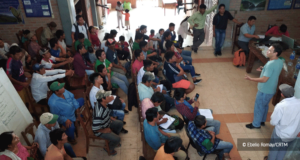Supporting the Fight to Protect Biodiversity and Indigenous Territories in Bolivia
March 29, 2023
Since 2022, Conservación Amazónica – ACEAA, our sister organization in Bolivia, has been an integral part of the Regional Implementation Team (RIT) for the Tropical Andes Biodiversity Hotspot of the Critical Ecosystem Partnership Fund (CEPF), which works to empower civil society to protect the world’s biodiversity hotspots. Through this partnership with the CEPF, Conservación Amazónica – ACEAA has been working on the ground with the indigenous communities of T’simane, Mosetene, and Tacana to empower them to conserve their territory in Bolivia’s Pilón-Lajas Biosphere Reserve and Communal Lands protected area.

The T’simane, Mosetene and Tacana indigenous peoples occupy the lowlands at the foothills of the Andes mountains, alongside the Bolivian Amazonian plains, an area with hilly terrain and rich wetlands. This territory is part of the Madidi – Pilón Lajas – Cotapata Ecological Corridor, which covers nearly 988,500 acres of forest, unique in that it is legally recognized as indigenous territories as well as an UNESCO-designated Biosphere Reserve.
Throughout history, the vast availability of natural resources in the region has led to increasing threats to the conservation of the forest and the protection of the Pilón Lajas Biosphere Reserve and Indigenous Territory. In recent years, these threats only continue to grow and intensify, including: mega hydroelectric dams, hydrocarbon prospecting, continued road encroachment into the forest, illegal settlements, and illegal gold mining, all of which put local communities and their livelihoods at risk.
In addition to these external threats, indigenous communities in the region face high poverty rates as a result of limited access to education and resources. To address these threats, the T’simane, Mosetene and Tacana have worked together to organize themselves through the T’simane Mosetene Regional Council (CRTM based on its name in Spanish). With the support of partners CEPF and the Wildlife Conservation Society, these communities worked together to develop a Life Plan, or Management Plan, for the Biosphere Reserve, which lays out a clear diagnosis of the state of the territory and how to deal with the biggest threats. Through these life plans, these indigenous groups will fight for autonomy over their territory and the sustainable management of their natural resources in order to conserve the region’s biodiversity and improve their livelihoods.
Also through the Life Plan, the CRTM regional council has also incorporated activities to help strengthen and empower the communities’ populations in the areas of leadership, governance, communication, and financial sustainability. The Life Plan also includes activities that support local economic development, such as the sustainable harvest of forest products as well as strengthening female business leaders in the communities who are responsible for their family’s or communities’ food security. The regional council has also laid the groundwork to prepare young leaders, including providing training in indigenous rights, partnering with other actors for support, and other ways to prepare themselves to defend and manage their territory.
This approach to forest conservation has repercussions at both the macro- and micro levels: it both directly and indirectly benefits indigenous communities living in the Tropical Andes Hotspot while also encouraging the protection of one of the world’s largest carbon reserves, one of the largest freshwater reserves, and one of the most diverse regions for fauna and flora on the planet.
Through Conservación Amazónica – ACEAA’s work as a partner of CEPF, we are proud to be part of a collective effort to provide sustainable support to execute the CRTM’s Life Plan to not only improve the livelihoods of the T’simane, Mosetene and Tacana indigenous peoples and the sustainable management of forest resources, but to also empower these communities to protect their territories, be the local guardians of this biodiversity as they have for millennia, and keep the forest standing for the benefit of all across the globe.

